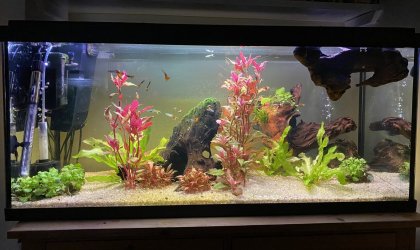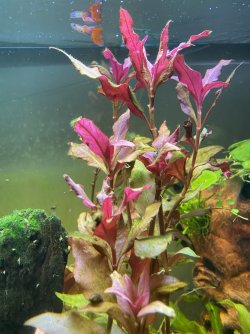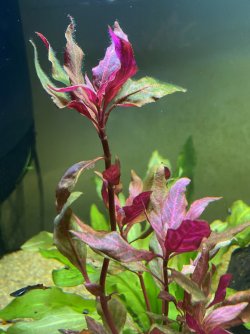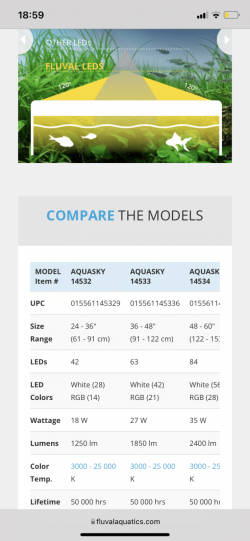Funkyfishgorl
New Member
- Joined
- Dec 10, 2019
- Messages
- 31
- Reaction score
- 4
Hi, I’m looking for advice as I’m struggling with hair algae in my tank (100cm x 40cm x 50cm) approx 160L/40G. So I’m considering amano shrimp but concerned about my zebra loaches.
Plants:
I’ve attached a photo so you can see the plants I have and the type of algae growing, it’s mainly the slow growing plants that have hair algae issues. I’m also adding a few more plants today as I read that lots of plants taking up all the nutrients can help. It’s mainly full of slow growing plants, I know not good! The only fast growers are the red tiger lotus in the back (which you can’t see as it’s tiny), the pennywort and wavy lobelia. I have hair algae issues mostly on alternanthera reineicki (the tallest) so I cut 98% of the algae covered leaves off then but that gives an ugly leggy appearance compared to how bushy it used to be so manual removal is not working for me. I don’t have CO2 nor do I want to invest in it as it’s too expensive for me.
Lighting:
I have two FluvalSmart Aquaskys form my smaller tanks on it plus the light that came with the tank which is surprisingly very bright. I feed them weekly through the water column but have been meaning to get root tabs for a while. My lights have a sunrise setting on from 9-10 then sunset at 6-6:30 and a 100% blue with a 1% red until 7. The other light comes on 10-6.
Stocking:
Currently in the tank is about 20 make guppies, 1 oto and in a few days when their quarantine is over 5 zebra loaches (straita) and 3 otos. I know my loaches eat snails and would eat baby shrimp, thankfully amano shrimp need brackish water so that’s no issue. But I don’t want them to be terrorised by the loaches, plus the LFS usually has very small shrimp so they would start off small.
I’d really appreciate any advice with my tank, it’d be particularly helpful to get suggestions for hair algae eating species that are good tank mates. I researched flagfish but apparently they are very nippy so even though I was thinking of just getting one, I know from previous experience that you can find a particularly aggressive personality. It would be helpful and interesting to hear other peoples experiences with them. Thanks for checking this out.
Plants:
I’ve attached a photo so you can see the plants I have and the type of algae growing, it’s mainly the slow growing plants that have hair algae issues. I’m also adding a few more plants today as I read that lots of plants taking up all the nutrients can help. It’s mainly full of slow growing plants, I know not good! The only fast growers are the red tiger lotus in the back (which you can’t see as it’s tiny), the pennywort and wavy lobelia. I have hair algae issues mostly on alternanthera reineicki (the tallest) so I cut 98% of the algae covered leaves off then but that gives an ugly leggy appearance compared to how bushy it used to be so manual removal is not working for me. I don’t have CO2 nor do I want to invest in it as it’s too expensive for me.
Lighting:
I have two FluvalSmart Aquaskys form my smaller tanks on it plus the light that came with the tank which is surprisingly very bright. I feed them weekly through the water column but have been meaning to get root tabs for a while. My lights have a sunrise setting on from 9-10 then sunset at 6-6:30 and a 100% blue with a 1% red until 7. The other light comes on 10-6.
Stocking:
Currently in the tank is about 20 make guppies, 1 oto and in a few days when their quarantine is over 5 zebra loaches (straita) and 3 otos. I know my loaches eat snails and would eat baby shrimp, thankfully amano shrimp need brackish water so that’s no issue. But I don’t want them to be terrorised by the loaches, plus the LFS usually has very small shrimp so they would start off small.
I’d really appreciate any advice with my tank, it’d be particularly helpful to get suggestions for hair algae eating species that are good tank mates. I researched flagfish but apparently they are very nippy so even though I was thinking of just getting one, I know from previous experience that you can find a particularly aggressive personality. It would be helpful and interesting to hear other peoples experiences with them. Thanks for checking this out.
Attachments
Last edited:






